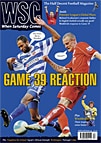 The US market is not exactly enthralled with the prospect of another foreign football circus passing through town as they see plenty of them already. Mike Woitalla reports from the land of opportunity
The US market is not exactly enthralled with the prospect of another foreign football circus passing through town as they see plenty of them already. Mike Woitalla reports from the land of opportunity
Forgive us if the prospect of English Premier League games in the United States didn’t get us all giddy. We’ve got so much soccer here already that a couple more games just wouldn’t be a very big deal. In 2007, the USA hosted more than 60 matches between foreign clubs. Include games that pitted visiting clubs against American teams and the figure passes 100. Besides the touring clubs, 40 national-team matches – not including the USA’s own 12 games – took place on our soil in 2007. And that’s not counting when Haiti, Fiji and China played against club teams.
No other nation attracts so much international soccer. Teams from virtually anywhere can find venues in the USA where immigrant populations will flock to the stadium. And so large has the general American soccer fanbase grown that big-name teams can fill the nation’s largest stadiums in nearly any metropolitan area. Suitable grounds abound, thanks to professional and college gridiron football. “We have 50 stadiums that could host World Cup games two days from now,” Sunil Gulati, the president of the US Soccer Federation, said recently.
In 2006, Los Angeles, Houston and New York hosted three Barcelona matches – against two Mexican clubs and the New York Red Bulls – which averaged crowds of 80,734. In recent years, teams such as Manchester United, Juventus, AC Milan and Real Madrid have also drawn huge crowds for exhibitions. With the exception of the InterLiga, in which eight Mexican teams compete for qualification for South America’s Copa Libertadores, and the Concacaf Champions Cup, the slew of USA-hosted international club games are friendlies.
That brings into question the notion that Richard Scudamore’s Game 39 scheme would be of particular appeal to American fans because the games would count towards the Premier League standings. What actually matters is which clubs would come. Woweee! Wigan vs. Bolton anyone? is how Soccer America magazine headlined its coverage of the Game 39 scheme, in which columnist Paul Gardner wrote: “And over half the games are going to be of that level… The EPL ‘brand’ is nowhere near as attractive as the EPL seems to think it is. For sure, Manchester United, Arsenal and Liverpool would excite American fans, but Scudamore’s plan has cities bidding for Premier League games and then taking the games they are given.”
When Chelsea toured the States for the third straight year last summer, the identity of their opponents had much to do with the size of the crowd. Most of the 47,329 who attended their northern California game against Club America supported the Mexican club. A sellout crowd of 27,000 came for the game against David Beckham’s Los Angeles Galaxy. And southern California’s Korean expat community supplied most of the enthusiasm among the 15,349 who watched the Blues play South Korea’s Suwon Samsung Bluewings.
In 2003, when Manchester United averaged 68,000 fans for four games in the USA, the opponents were Celtic, Club America, Juventus and Barcelona. But if Chelsea played a league game in the USA against a team such as Portsmouth, they would likely draw a smaller crowd than when playing them back in England. Latin American teams, on the other hand, can draw bigger crowds in the USA than at home because of the enthusiasm of the immigrant community. That the average ticket price for a Mexican national-team game played in the USA is about six times more than for one staged in Mexico is only one reason why they play so many games in the USA.
“When we see that more than 42,000 people watched Mexico play Guatemala in a friendly game in Los Angeles,” says Adrian Sierra de Anda, a reporter for Mexico City daily El Universal, “we can’t believe it. That game would not draw nearly as well in Mexico City.” Mexico are the most frequent national-team visitors. Last year they played more games (11) north of the border than in their own country (four). Other national teams that played at least twice in the USA in 2007 included Brazil, Colombia, Ireland and Switzerland. And nearly every Central American country played a couple of games in the USA. Mexico also provides the most frequently visiting club teams, but the 20 nations that sent sides to US shores in 2007 included Portugal, Scotland, Argentina, Brazil, Spain, Italy and England.
All Mexican national-team games and most major international club games in the USA are promoted by Major League Soccer’s marketing arm, Soccer United Marketing (SUM), ensuring that MLS owners profit from what can be competition for their own product. Said MLS deputy commissioner Ivan Gazidis of the Game 39 proposal: “We are the premier promoter of international soccer in North America and clearly we would like to get involved.” That day may never come, considering the opposition from FIFA and from within England. So those pining for Middlesbrough and Birmingham will have to settle for the usual menu, which this summer promises tours by Real Madrid and Barcelona.
From WSC 254 April 2008